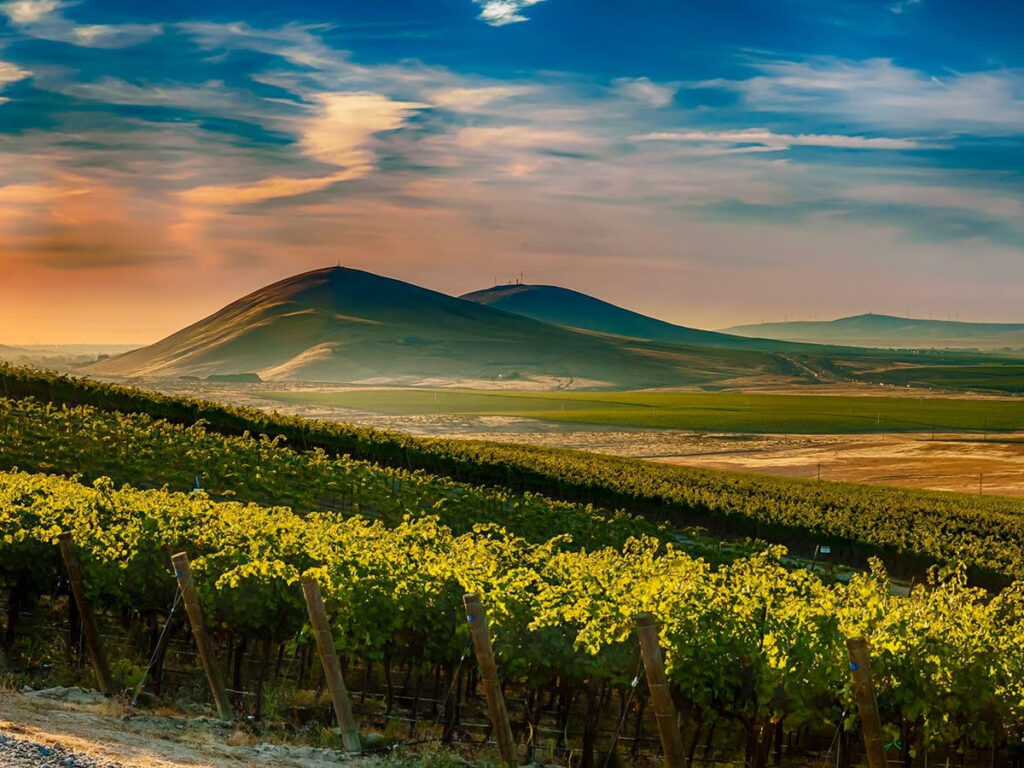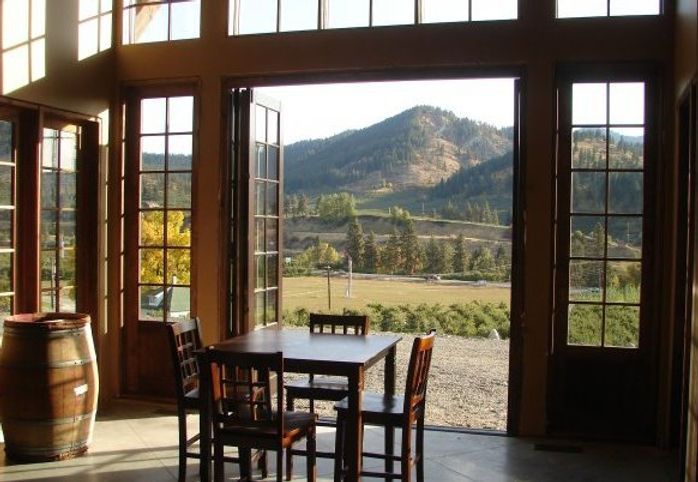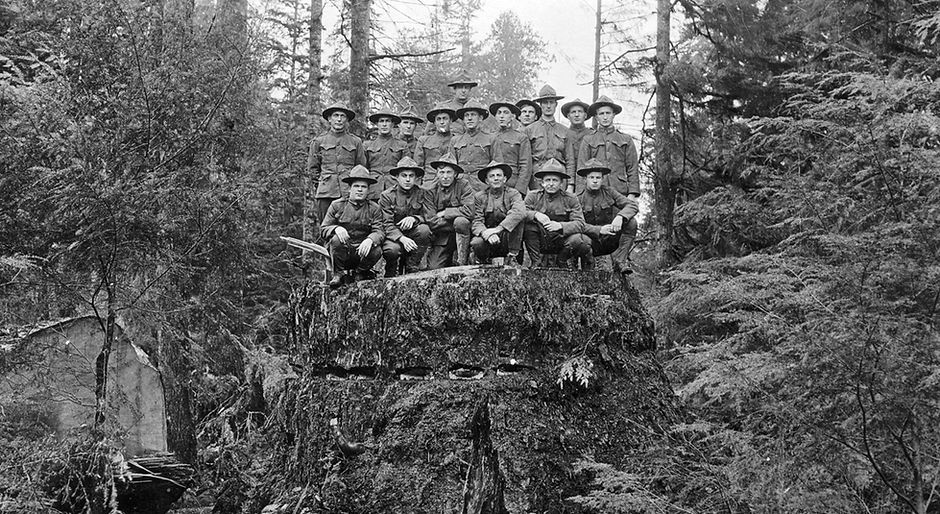We’ll just come right out and say it: Washington State produces some of the best wines in the world. This ancient land has been shaped by geological forces hundreds of millions of years in the making. As a result, there is a range of terroir as perfectly suited to growing pristine grapes. Consequently, crafting world-class wines as anywhere in the United States.
At Silvara Cellars, our guiding principles have always been the same. Crafting small-production wine from the very best vineyard sites in the Pacific Northwest. Additionally, expressing the majesty of this land in every bottle we produce.
We take deep, passionate pride to be making wine in Washington State. We hope you feel the same sense of excitement that we do every time you take a sip. From the sweeping vistas of the Cascades to the woodlands and ancient soils that define our amazing terroir, our wines embody everything that makes the Pacific Northwest so special.
This is Washington State. This is Silvara Cellars.

Where We Source

Our wines are produced from grapes grown in Washington’s top vineyards. They express the land of the most important AVAs in the state. As the great winemakers of France often say: “our job is to craft wine that serves as a unique, delicious lens through which these appellations and vineyards express themselves”.
Candy Mountain
In 2020, Washington welcomed its 16th official AVA with the freshly-minted Candy Mountain AVA. Sitting a few miles west of the Yakima/Columbia River confluence, it’s also Washington’s smallest AVA with only 815 acres to its name. In the namesake 50-acre Candy Mountain Vineyard -now owned by the Oregon Potato Co.- the vines bask in the midday heat and cool off in the chilly nights. Red wine varieties reign here: Grenache, Sangiovese, Mourvèdre, and Malbec, among them. The acclaimed Long Shadows Vintners are longtime customers. We source uses Candy Mountain’s grapes to give a generous lift to our Merlot and Cabernet Sauvignon blends.


Evergreen Vineyards
Founded by Butch and Jerry Milbrandt of Milbrandt Vineyards in the late 1990s. Evergreen Vineyards in George, Washington, is about 1,200 acres of ideal land for growing great white wine grapes. It is part of the Ancient Lakes AVA, which is a cooler climate pocket within the greater Columbia Valley AVA. It boasts silty loam and caliche soils (white-gray, almost cream-colored with cemented carbonates) atop cliffs overlooking the nearby Columbia River. Evergreen has even been hailed as a “Vineyard of the Year” by Seattle Magazine. Additionally, some notable producers are Eroica, L’Ecole No. 41, Seven Hills, and Chateau Ste. Michelle, to name a few. At Silvara, we source prime Chardonnay grapes from this fantastic estate.
Newhouse Farms (Upland Vineyard)
The family behind Newhouse Farms has been working the land since 1913. Their expertise in crop-growing is threefold: hops, tree fruits, and excellent wine grapes. The Newhouses maintain Upland Vineyard, an upthrust of land on Snipes Mountain with old soil unaffected by the great Missoula Floods of the Ice Age (a unique distinction from its fellow Yakima Valley vineyards). Because the land has particular magic at work, it was designated as its own Snipes Mountain AVA in 2009. Between their unique soils and extra heat-reflecting rocks, Upland becomes a steady grower for various grape varieties: Cabernet Sauvignon, Grenache, Chardonnay, Chenin Blanc, and a Muscat that’s ideal for making ice wine. About 25 producers love to pick Upland’s fantastic grapes, among them Chateau Ste. Michelle and Betz Family Winery.


Sundance Vineyards
Farmed by Jerry Milbrandt, this site is situated on the Wahluke Slope AVA and comprises gravel, sand, and volcanic soils. With limited rainfall and warm sunny days, the location is ideal for red wine grapes, like Merlot, Cabernet Sauvignon, and Syrah—made famous by K Vintners for its “The Deal” bottle. White wine grapes also do well here, and we at Silvara like to pinch some of those for our Chardonnay blends.
Purple Sage
Also farmed by the Milbrandt’s, Purple Sage makes its home in Mattawa and helps form part of the Wahluke Slope AVA. Producers like Almquist and Kyra proudly display the vineyard name on some of their labels. We have our eyes on the Dolcetto grapes, most commonly grown in Piedmont, Italy; however, they thrive near the banks of the mighty Columbia River, where we harness its rich, velvety profile for our use.


Canoe Ridge Vineyard
Nestled along the northern bank of the Columbia River, where it serves as a border between Washington and Oregon, Canoe Ridge is a powerhouse vineyard of the Horse Heaven Hills AVA. With a dry climate, sandy soils, and brisk winds, the 181-acre Canoe Ridge has proven to be a special spot for exceptional Merlot, Chardonnay, Syrah, and Cabernet Sauvignon. Canoe Ridge produces their wines from the site. And Chateau Ste Michelle is also a customer. We source Canoe Ridge’s Riesling to craft a dynamo High Mountain Huckleberry fruit wine rosé that blows all other fruit wines over to the Oregon side of the river (in our humble opinion)!
Skyfall
Located near a bend in the Yakima River in Benton City, Washington—some 20 miles west of Kennewick––Skyfall gets its name from the car-sized boulders scattered across the land that look as if they fell from the sky. These boulders are remnants of the great Missoula Floods, which gave the land its sand-laced silt loam soil full of granite deposits. Due to this, the vineyard was made a choice location to grow some premium wine grapes. We know that Cabernet Sauvignon, Pinot Gris, Merlot, and Chardonnay make a happy home here. However, the secret of Skyfall is its Malbec and its Dolcetto.


Quintessence
Situated between the Yakima River and the slope of Red Mountain (and in the Red Mountain AVA) lies Quintessence Vineyard, one of the great secret plots of prime vineyard land in the AVA (though word has certainly gotten out, so, it’s not so much a secret anymore.) Farmed by the Shaws of Shaw Vineyards, the 323-acre Quintessence is home to a variety of loamy soils, and the majority of grapes planted are Merlot, Malbec, Cabernet Sauvignon. We source Petit Verdot from this coveted site.
Canyon Vineyard Ranch
The Canyon Vineyard Ranch is home to cherry orchards, apple orchards, and 315 acres of pristine wine grapes nestled among the rolling hills and varied microclimates of the Yakima Valley AVA. The climate and sandy loam soils at the Ranch make it ideal for growing Chardonnay, Pinot Gris, Syrah, and Merlot. It is also ideal for growing Malbec and Carménère. As a matter of fact, these last two varieties are the ones we hang our hats on.


McNary
Who doesn’t love a vineyard with a river view? Atop the basalt cliffs of the Horse Heaven Hills AVA overlooking the Columbia River, McNary Vineyard gives off the impression of a sort of hilltop vineyard oasis above layers and layers of beige and grey earth. McNary’s over 600-acre lot benefits from the kind of wind- and river-tempered air that ushers in refreshing breezes all growing season long, keep pests at bay, and slows ripening, which aides in the retention of vibrant acidity. Grapes that thrive here are Chardonnay, Riesling, Sauvignon Blanc for the whites, and Merlot, Syrah, and Cabernet Sauvignon for the reds. And we’re in good company. The site is also a source for producers like Ancient Wisdom, Lewis & Clark, and Jinxed.
Beverly Vineyards
One look at Beverly Vineyard, and you’d think it fell out of the sky and landed in the rugged sagebrush landscape of the wild west. A beneficiary of the famous Missoula Flood loamy soil, Beverly’s vines sweat out their grapes in the hot climate. It’s a literal hotbed of red varieties: Cabernet Franc, Merlot, and Mourvèdre among them. Producer Columbia Crest picks grapes from the Beverly vines, and Beverly’s Merlot and Cabernet Sauvignon make up part of our enticing Bordeaux-style Vintner’s Reserve red blend.


Solstice Vineyard (Willard Farms)
Jim Willard runs the show at this lovely vineyard full of old vine Chenin Blanc and other fine grapes that sits at the highest point in north-central Yakima Valley. Soils here are a mix of volcanic uplift with Missoula Flood sediment runoff. The vineyard’s lofty elevation helps temper the area’s hot days and cold nights. James Rahn, Gersing Cellars, Pacific Rim, and Division have used Solstice’s Chenin Blanc, Cabernet Sauvignon, and Gamay grapes. Simultaneously, we carefully select and harvest Malbec grapes to create a profound impact in our 2018 deep purple Malbec blend.
Weinbau
Weinbau’s 460 acres of wine grapes sit on the Wahluke Slope AVA’s eastern edge under the banner of Sagemoor Vineyards with the Saddle Mountains to the north and the Rattlesnake Mountains to the south. Who’s responsible for Weinbau’s greatness? Certainly, all fingers point to award-winning Vineyard Manager Miguel Rodriguez, who first arrived at Sagemoor in 1979 while still a teenager. What started as a smaller outfit of Riesling, Chardonnay, and Gewürztraminer later ballooned to include Cabernet Sauvignon, Syrah, Mourvèdre, Grenache. Besides, today boasts one of the largest crops of Cabernet Franc in all of Washington. Weinbau is a coveted destination, attracting a client list of up to 50 wine producers. Silvara is, of course, one of the happy customers using Weinbau fruit for the Malbec.


Blue Mountain Vineyards
Blue Mountain is one of the cooler sites managed by Sleight of Hand Cellars, which Robert Parker’s Wine Advocate has praised as “Up there with the créme de la créme of [Washington] state (and beyond).” Soils at Blue Mountain combine loess and silt loams where Cabernet Sauvignon and Cabernet Franc, Petit Verdot, and Merlot grow with ease and great intensity. And yes! When the lighting’s just right, the Blue Mountains -as shown on its name- do look blue!
Roosevelt Ridge
Many vineyard managers like to credit the flavor of their grapes to things like their soil makeup, climate, or annual rainfall. At Roosevelt Ridge on the banks of the Columbia River, the grape whisperer is the wind. Harsh winds in the area blow through the vines at Roosevelt Ridge, producing grapes with tough skins—like Petite Sirah, which delivers a heady dose of robust, muscular tannins in a finished wine. At Silvara, we like the way the wind shapes the Malbec grapes rooted in this wind-blown site. Thus, we’ve helped ourselves to quite a few tons of them. Despite the heavy winds, Roosevelt Ridge -managed by Clearwater Canyon Cellars- is among Washington’s more scenic vineyard landscapes.


Rasa Vineyards
Smack in the Rocks District of Milton Freewater AVA, Rasa Vineyards was planted in 2016. The Rocks District AVA takes its name from the cobblestones littered over the land. The heat radiated off these surface cobblestones help mature the grapes, and the coarse-grain alluvial soils and large stones here are notedly similar to the famous Galets roulés of the Châteauneuf-du-Pape region in France. Syrah is the Rasa’s big grape on campus, and we leverage these grapes for our explosively aromatic Syrah.

SILVARA
LATIN, silva 1. relating to, or inhabiting the forest
EGYPTIAN, ra 1. patron of the sun


Our Winemaker
GARY SEIDLER
FOUNDER & WINEMAKER
Silvara Cellars was founded by winemaker Gary Seidler in 2008. Gary’s approach to winemaking is a traditional one. Seeking out grapes from the best growers and distinct AVA’s in Washington State. Bringing out the natural depth and complexity in that fruit. And crafting terroir-driven wines that reflect their distinct appellations.
Like many of the best winemakers in the United States, he came to it later in life.
After a stint as a touring sound tech in the 1970s, Gary went on to found six different companies. Each on of these companies with its own distinct challenges, setbacks, and victories. After selling his sixth business he retired at the age of 48. That was when Gary realized he had the passionate desire to get back to a simpler, more meaningful lifestyle.
Having grown up working in agriculture and surrounded by a large Italian-German family in upstate New York. What we now refer to as “farm to table” -grandmothers who baked, uncles who cured meats and cheeses- were just another Sunday supper for Gary. It left an impression on him.
At the age of 52, he began working toward his degree in viticulture and enology at U.C. Davis, one of the most prestigious universities in the world for the study of grape-growing and winemaking.
Training with some of the best growers and winemakers in Washington’s wine country, Gary had the opportunity to start a winery in either Napa or Washington State. Napa already had a strong reputation in the wine world, whereas Washington had…well, everything else. From its economics to the diversity of distinct growing regions, Gary could see that the Pacific Northwest was ripe with untapped potential. With plans drawn up by renowned Montana architect Jeri Locati, Gary grabbed his tool belt and a 6-ft. ladder. Consequently, he began building his tasting room in the foothills of Washington’s Cascade Mountains.
SILVARA CELLARS
He named his winery Silvara, which is derived from a Latin word that means “of the forest.” The name is not only a tribute to the Evergreen State, but it is also a tribute to those individuals who brave the woods of impossibility to take up the challenge of writing their own pioneering story.
Now in his 15th year at Silvara Cellars, and after a lifetime of finding success in other fields, Gary has done just that. And with each vintage, that story continues to unfold.
Silvara Cellars is the leading winery in Leavenworth, WA
VISIT OUR WINERY
Nestled just outside Leavenworth, WA, Silvara Cellars offers an unparalleled wine tasting experience. Immerse yourself in the beauty of the Cascade foothills and woodlands at Silvara Cellars Tasting Room, where breathtaking views await. Our on-site sommeliers are on hand to guide you through our award-winning wines. We offer wine by the glass and a selection of full bottles of wine. And for those who prefer to enjoy Silvara Cellars from the comfort of their own home, we offer convenient pick up or delivery options.

Let us introduce you to the best wine in Leavenworth, WA

the Silvan Society
PROUDLY POURING SINCE 2008
As a member of our exclusive Wine Club, the Silvan Society, you’ll have the privilege of being the first to taste our limited production wines, along with other exciting offerings and perks throughout the year.

